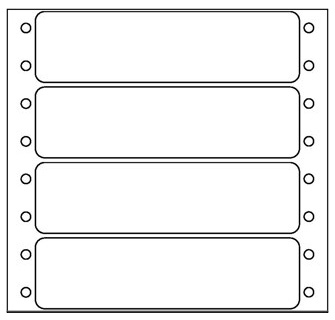Order Blank Labels in different sizes.
Comprehending How Blank Labels Job to Enhance Your Labeling Experience
Understanding the technicians of blank labels is important for optimizing your labeling methods across various contexts. These functional tools provide significant advantages, such as modification and versatility, making them a fitting option for both expert setups and individual use. From inventory monitoring to home organization, the effects of their tactical application can lead to enhanced performance. To fully comprehend how these labels can transform your processes, one must take into consideration the different types readily available and the myriad methods they can be customized to suit details needs.

Benefits of Using Blank Labels
Blank labels offer a functional option for various labeling requirements, making them indispensable in both personal and specialist settings. Their adaptability permits users to create tailored labels tailored to details demands, enhancing business efficiency. Whether made use of in office, retail environments, or commercial applications, blank labels facilitate the identification and categorization of products, papers, and personal products.
One substantial benefit of blank labels is their cost-effectiveness. By enabling customers to print only the labels they need, waste is decreased, and inventory administration comes to be more workable. Furthermore, blank labels are suitable with numerous printing methods, including inkjet and laser printers, making them obtainable for different users.

Furthermore, using blank labels simplifies the process of upgrading information, as individuals can easily print brand-new labels to change outdated ones, making sure that all products and papers are properly labeled. On the whole, blank labels offer a functional and efficient labeling service for varied applications.
Kinds of Blank Labels Available
What options are available when it comes to blank labels? Blank labels come in a range of kinds, each matched for various applications and choices.
Another prominent choice is artificial labels, often made from materials like polyester or vinyl. These labels are understood for their longevity and resistance to water, chemicals, and tearing, making them appropriate for rough atmospheres. They are generally made use of in industrial settings or for labeling products that may be subjected to wetness.
In addition, there are thermal transfer labels, which require a printer that uses heat to move ink onto the tag surface area. These labels are preferred for their top quality print and durability.
Lastly, specialty labels satisfy specific demands, such as detachable labels for short-lived usage or high-temperature labels for severe problems. Recognizing these alternatives allows customers to pick one of the most appropriate blank tag for their unique labeling requirements.
Customization Options for Labels
A broad range of customization options is readily available for labels, permitting customers to customize them to particular needs and branding requirements. Users can pick from numerous dimensions, shapes, and products to make sure that the labels efficiently fit their intended objective. Typical materials consist of paper, polyester, and vinyl, each supplying various levels of resilience and visual charm.
Color options play a crucial role in modification, allowing brand names to preserve consistency with their business identity. Individuals can select from more helpful hints a range of colors or perhaps opt for personalized printing to match particular branding components. Additionally, labels can be published with distinct layouts, logos, and text, boosting brand acknowledgment and aesthetic effect.
An additional essential facet is the choice of adhesive. Labels can be made with permanent, detachable, or repositionable adhesives, relying on the application needs. This flexibility enables reliable labeling options across numerous atmospheres, from retail to industrial settings.

Tips for Effective Labeling
Efficient labeling goes beyond modification; it also entails calculated considerations that boost performance and interaction. To accomplish effective labeling, start by plainly defining the purpose of each label.
Next, focus on visibility by choosing appropriate shades and fonts. High comparison in between text and history enhances readability, while bigger fonts assist in fast identification. In addition, guarantee that labels are placed in a consistent and sensible manner, making it much easier for users to find and analyze information.
Consider the toughness of labels. find this Choose materials fit for the specific atmosphere where the labels will certainly be used, whether it be inside your home or outdoors. Waterproof or tear-resistant choices might be necessary depending upon the context.
Last but not least, frequently testimonial and update your labels to reflect any type of adjustments in information or usage. This positive approach not only preserves quality but also prevents complication over time. By adhering to these tips, you can make best use of the effectiveness of your labeling efforts, guaranteeing they offer their intended function successfully.
Applications of Blank Labels
Blank labels provide various applications across different markets, making them a very useful tool for organization and communication. These versatile labels are generally made use of in warehouses for inventory administration, permitting companies to quickly determine and track items. By using blank labels to storage space containers, you can try this out racks, or pallets, business can simplify their operations and reduce the possibility of errors.
In the healthcare sector, blank labels play a vital function in identifying medications and medical products, ensuring correct recognition and use. Adjustable labels can include important information such as dose, expiry dates, and patient information, boosting security and compliance.
In retail, blank labels assist in rates items, supplying promos, or identifying shelf areas, which inevitably enhances the client experience. They allow for quick updates to prices or product info without the requirement for pre-printed labels.
Moreover, blank labels are useful for personal usage, such as organizing home workplaces, crafting, or labeling food containers. Their flexibility allows people to create customized solutions that fulfill particular demands. In general, the applications of blank labels are considerable, highlighting their relevance in promoting performance and clarity in numerous settings.
Final Thought
To conclude, blank labels provide a functional and efficient option for various identifying demands. Their adaptability in size, form, and product enables customized applications throughout different atmospheres. By leveraging modification options and efficient labeling approaches, organizations can improve clearness and interaction (Blank Labels). Ultimately, the combination of blank labels right into operational processes adds to improved effectiveness, making them an important source for both individual and expert usage.